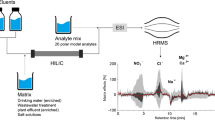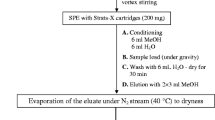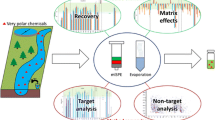Abstract
The determination of trace-level pharmaceuticals in water is generally performed using liquid chromatography combined with mass spectrometry, which is susceptible to interference from non-target substances, such as natural organic matter (NOM). In this study, the interference of NOM on the determination of 20 typical pharmaceuticals using solid-phase extraction followed by ultra-performance liquid chromatography–electrospray ionization-triple quadrupole mass spectrometry (UPLC–ESI-tqMS) was investigated with a combined consideration of recoveries, matrix effects, and process efficiencies. The results showed that the recoveries of most pharmaceuticals were not significantly affected by NOM concentrations of 1–50 mg/L. The matrix effects and process efficiencies decreased linearly with increasing logarithmic NOM concentrations, and the changes in matrix effects and process efficiencies both exhibited negative linear correlations with the pharmaceuticals’ hydrophobicity (logKow). This result indicated that the determination of hydrophilic pharmaceuticals suffered from more severe NOM interference, as NOM entered the ESI source together with hydrophilic pharmaceuticals after UPLC separation and subsequently weakened the ionization efficiency of these pharmaceuticals. According to the correlations between logKow and the changes in matrix effects and process efficiencies, the pharmaceutical determination in positive/negative ESI modes with logKow ≤ 3.80/4.27 is considered to be significantly affected by NOM, accompanied by > 20% changes in matrix effects and process efficiencies.




Similar content being viewed by others
Data availability
The data that support the findings of this study are available on reasonable request from the corresponding author.
References
aus der Beek T, Weber FA, Bergmann A, Hickmann S, Ebert I, Hein A, Kuster A (2016) Pharmaceuticals in the environment—global occurrences and perspectives. Environ Toxicol Chem 35(823):835. https://doi.org/10.1002/etc.3339
Bienvenu JF, Provencher G, Belanger P, Berube R, Dumas P, Gagne S, Gaudreau E, Fleury N (2017) Standardized procedure for the simultaneous determination of the matrix effect, recovery, process efficiency, and internal standard association. Anal Chem 89:7560–7568. https://doi.org/10.1021/acs.analchem.7b01383
Chen F, Peldszus S, Elhadidy AM, Legge RL, Van Dyke MI, Huck PM (2016) Kinetics of natural organic matter (NOM) removal during drinking water biofiltration using different NOM characterization approaches. Water Res 104:361–370. https://doi.org/10.1016/j.watres.2016.08.028
Dimpe KM, Nomngongo PN (2016) Current sample preparation methodologies for analysis of emerging pollutants in different environmental matrices. Trends Analyt Chem 82:199–207. https://doi.org/10.1016/j.trac.2016.05.023
Ebele AJ, Abou-Elwafa Abdallah M, Harrad S (2017) Pharmaceuticals and personal care products (PPCPs) in the freshwater aquatic environment. Emerging Contaminants 3:1–16. https://doi.org/10.1016/j.emcon.2016.12.004
Fu H, Liu K, Alvarez PJJ, Yin D, Qu X, Zhu D (2019) Quantifying hydrophobicity of natural organic matter using partition coefficients in aqueous two-phase systems. Chemosphere 218:922–929. https://doi.org/10.1016/j.chemosphere.2018.11.183
Gonzalez-Marino I, Quintana JB, Rodriguez I, Gonzalez-Diez M, Cela R (2012) Screening and selective quantification of illicit drugs in wastewater by mixed-mode solid-phase extraction and quadrupole-time-of-flight liquid chromatography–mass spectrometry. Anal Chem 84:1708–1717. https://doi.org/10.1021/ac202989e
Guitart C, Readman JW (2010) Critical evaluation of the determination of pharmaceuticals, personal care products, phenolic endocrine disrupters and faecal steroids by GC/MS and PTV-GC/MS in environmental waters. Anal Chim Acta 658:32–40. https://doi.org/10.1016/j.aca.2009.10.066
Gustavsson J, Ahrens L, Nguyen MA, Josefsson S, Berggren Kleja D, Wiberg K (2017) Influence of natural organic matter on the extraction efficiency of flame retardants from surface waters. J Chromatogr A 1524:74–86. https://doi.org/10.1016/j.chroma.2017.10.004
Hu HY, Du Y, Wu QY, Zhao X, Tang X, Chen Z (2016) Differences in dissolved organic matter between reclaimed water source and drinking water source. Sci Total Environ 551–552:133–142. https://doi.org/10.1016/j.scitotenv.2015.12.111
Hughes SR, Kay P, Brown LE (2013) Global synthesis and critical evaluation of pharmaceutical data sets collected from river systems. Environ Sci Technol 47:661–677. https://doi.org/10.1021/es3030148
Jeanneau L, Jarde E, Gruau G (2011) Influence of salinity and natural organic matter on the solid phase extraction of sterols and stanols: Application to the determination of the human sterol fingerprint in aqueous matrices. J Chromatogr A 1218:2513–2520. https://doi.org/10.1016/j.chroma.2011.02.066
Kaur H, Bansiwal A, Hippargi G, Pophali GR (2018) Effect of hydrophobicity of pharmaceuticals and personal care products for adsorption on activated carbon: Adsorption isotherms, kinetics and mechanism. Environ Sci Pollut Res 25:20473–20485. https://doi.org/10.1007/s11356-017-0054-7
Kruve A, Leito I, Herodes K (2009) Combating matrix effects in LC/ESI/MS: The extrapolative dilution approach. Anal Chim Acta 651:75–80. https://doi.org/10.1016/j.aca.2009.07.060
Li S, Shi W, Liu W, Li H, Zhang W, Hu J, Ke Y, Sun W, Ni J (2018) A duodecennial national synthesis of antibiotics in China’s major rivers and seas (2005–2016). Sci Total Environ 615:906–917. https://doi.org/10.1016/j.scitotenv.2017.09.328
Martinez-Hernandez V, Meffe R, Herrera S, Arranz E, de Bustamante I (2014) Sorption/desorption of non-hydrophobic and ionisable pharmaceutical and personal care products from reclaimed water onto/from a natural sediment. Sci Total Environ 472:273–281. https://doi.org/10.1016/j.scitotenv.2013.11.036
Matuszewski BK, Constanzer ML, Chavez-Eng CM (2003) Strategies for the assessment of matrix effect in quantitative bioanalytical methods based on HPLC–MS/MS. Anal Chem 75:3019–3030. https://doi.org/10.1021/ac020361s
Ohlenbusch G, Zwiener C, Meckenstock RU, Frimmel FH (2002) Identification and quantification of polar naphthalene derivatives in contaminated groundwater of a former gas plant site by liquid chromatography–electrospray ionization tandem mass spectrometry. J Chromatogr A 967:201–207. https://doi.org/10.1016/S0021-9673(02)00785-9
Pena OIG, Zavala MAL, Ruelas HC (2021) Pharmaceuticals market, consumption trends and disease incidence are not driving the pharmaceutical research on water and wastewater. Int J Environ Res Public Health 18:2532. https://doi.org/10.3390/ijerph18052532
Perez-Fernandez V, Mainero Rocca L, Tomai P, Fanali S, Gentili A (2017) Recent advancements and future trends in environmental analysis: Sample preparation, liquid chromatography and mass spectrometry. Anal Chim Acta 983:9–41. https://doi.org/10.1016/j.aca.2017.06.029
Qiu J, Huang Y, Wu Y, Shi P, Xu B, Chu W, Pan Y (2020) Detection, transformation, and toxicity of indole-derivative nonsteroidal anti-inflammatory drugs during chlorine disinfection. Chemosphere 260:127579. https://doi.org/10.1016/j.chemosphere.2020.127579
Renew JE, Huang CH (2004) Simultaneous determination of fluoroquinolone, sulfonamide, and trimethoprim antibiotics in wastewater using tandem solid phase extraction and liquid chromatography–electrospray mass spectrometry. J Chromatogr A 1042:113–121. https://doi.org/10.1016/j.chroma.2004.05.056
Sagawa N, Takino T, Kurogochi S (2006) A simple method with liquid chromatography/tandem mass spectrometry for the determination of the six trichothecene mycotoxins in rice medium. Biosci Biotechnol Biochem 70:230–236. https://doi.org/10.1271/bbb.70.230
Saka K, Kudo K, Hayashida M, Kurisaki E, Niitsu H, Terada M, Yamaguchi K, Yoshida K (2013) Relationship between the matrix effect and the physicochemical properties of analytes in gas chromatography. Anal Bioanal Chem 405:9879–9888. https://doi.org/10.1007/s00216-013-7433-9
Stahnke H, Kittlaus S, Kempe G, Alder L (2012) Reduction of matrix effects in liquid chromatography–electrospray ionization–mass spectrometry by dilution of the sample extracts: How much dilution is needed? Anal Chem 84:1474–1482. https://doi.org/10.1021/ac202661j
Tran NH, Hu J, Ong SL (2013) Simultaneous determination of PPCPs, EDCs, and artificial sweeteners in environmental water samples using a single-step SPE coupled with HPLC–MS/MS and isotope dilution. Talanta 113:82–92. https://doi.org/10.1016/j.talanta.2013.03.072
Trufelli H, Palma P, Famiglini G, Cappiello A (2011) An overview of matrix effects in liquid chromatography–mass spectrometry. Mass Spectrom Rev 30:491–509. https://doi.org/10.1002/mas.20298
USEPA (2016) Contaminant candidate list (CCL) and regulatory determination: Chemical contaminants–CCL 4. Available at https://www.epa.gov/ccl/chemical-contaminants-ccl-4
Wickramasekara S, Hernandez-Ruiz S, Abrell L, Arnold R, Chorover J (2012) Natural dissolved organic matter affects electrospray ionization during analysis of emerging contaminants by mass spectrometry. Anal Chim Acta 717:77–84. https://doi.org/10.1016/j.aca.2011.12.019
Wiest L, Chonova T, Berge A, Baudot R, Bessueille-Barbier F, Ayouni-Derouiche L, Vulliet E (2018) Two-year survey of specific hospital wastewater treatment and its impact on pharmaceutical discharges. Environ Sci Pollut Res 25:9207–9218. https://doi.org/10.1007/s11356-017-9662-5
Xiang Y, Wu H, Li L, Ren M, Qie H, Lin A (2021) A review of distribution and risk of pharmaceuticals and personal care products in the aquatic environment in China. Ecotoxicol Environ Saf 213:112044. https://doi.org/10.1016/j.ecoenv.2021.112044
Xu J, Yu HQ, Sheng GP (2016) Kinetics and thermodynamics of interaction between sulfonamide antibiotics and humic acids: Surface plasmon resonance and isothermal titration microcalorimetry analysis. J Hazard Mater 302:262–266. https://doi.org/10.1016/j.jhazmat.2015.09.058
Yang Y, Zhang X, Jiang J, Han J, Li W, Li X, Yee Leung KM, Snyder SA, Alvarez PJJ (2022) Which micropollutants in water environments deserve more attention globally? Environ Sci Technol 56:13–29. https://doi.org/10.1021/acs.est.1c04250
Yin T, Wu Y, Shi P, Li A, Xu B, Chu W, Pan Y (2020) Anion-exchange resin adsorption followed by electrolysis: A new disinfection approach to control halogenated disinfection byproducts in drinking water. Water Res 168:115144. https://doi.org/10.1016/j.watres.2019.115144
Zhang Q, Ying G, Pan C, Liu Y, Zhao J (2015) Comprehensive evaluation of antibiotics emission and fate in the river basins of China: Source analysis, multimedia modeling, and linkage to bacterial resistance. Environ Sci Technol 49:6772–6782. https://doi.org/10.1021/acs.est.5b00729
Zhou L, Ying G, Liu S, Zhao J, Chen F, Zhang R, Peng F, Zhang Q (2012) Simultaneous determination of human and veterinary antibiotics in various environmental matrices by rapid resolution liquid chromatography-electrospray ionization tandem mass spectrometry. J Chromatogr A 1244:123–138. https://doi.org/10.1016/j.chroma.2012.04.076
Zuo Y, Cheng S, Jiang H, Han Y, Ji W, Wang Z, Zhou Q, Li A, Li W (2022) Release and removal of algal organic matter during prechlorination and coagulation treatment of cyanobacteria-laden water: Are we on track? Sci Total Environ 824:153793. https://doi.org/10.1016/j.scitotenv.2022.153793
Funding
This work was financially supported by the National Key Research and Development Program of China (2021YFA0910300), the National Natural Science Foundation of China (52070093 and 51778280), Key Social Development Projects of Key R&D Plans in Jiangsu Province (BE2019708), and High-level Talent Team Project of Quanzhou City (2018CT006).
Author information
Authors and Affiliations
Contributions
Zheng Wang: methodology, validation, formal analysis, writing–original draft. Aimin Li: conceptualization, funding acquisition, supervision. Yufeng Liao: methodology, writing–review and editing. Chendong Shuang: funding acquisition, writing–review and editing. Yang Pan: funding acquisition, writing–review and editing. Yangyang Zhang: methodology, resources. Hongfang Sun: writing–review and editing. Qing Zhou: funding acquisition, supervision. Wentao Li: methodology, resources.
Corresponding author
Ethics declarations
Ethics approval and consent to participate
Not applicable.
Consent for publication
Not applicable.
Competing interests
The authors declare no competing interests.
Additional information
Responsible Editor: Ester Heath
Publisher's note
Springer Nature remains neutral with regard to jurisdictional claims in published maps and institutional affiliations.
Supplementary Information
Below is the link to the electronic supplementary material.
Rights and permissions
About this article
Cite this article
Wang, Z., Li, A., Liao, Y. et al. The key role of hydrophobicity in the determination of pharmaceuticals by liquid chromatography–electrospray ionization-mass spectrometry under the interference of natural organic matter. Environ Sci Pollut Res 29, 83071–83080 (2022). https://doi.org/10.1007/s11356-022-21674-0
Received:
Accepted:
Published:
Issue Date:
DOI: https://doi.org/10.1007/s11356-022-21674-0




